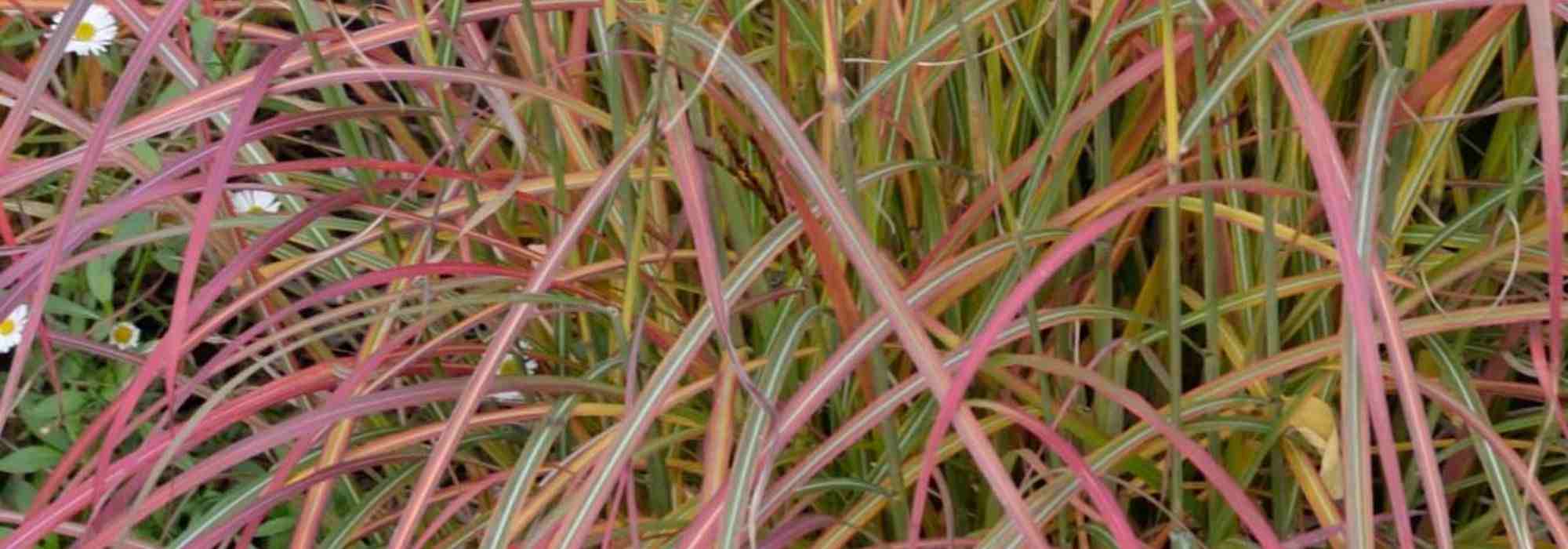
7 grasses for a South-facing garden
Sun-loving grasses for an extraordinary garden
Contents
Ornamental grasses bring a breath of fresh air to gardens. Their supple and graceful habit captures our attention under the play of light. Their subtle colour variations throughout the seasons add to their undulating effects with the slightest breeze. Most grasses need sunlight to thrive, and some are content with little, even dry soil. Discover our selection of eight grasses suited to sunny conditions.
To avoid any failures, we advise you to plant appropriately. Feel free to adopt our web application Plantfit.
Feather grass - Stipa tenuifolia
The Stipa tenuifolia, commonly known as feather grass, is a fresh green grass swaying with the slightest breeze. It is a wonderful hardy perennial that thrives in poor, dry soil conditions. Its green foliage is evergreen. Long inflorescences appear in summer as soft, silky pale blonde spikes, turning golden then bronze in autumn, gently arching towards the ground. Hardy down to -15°C in well-drained soil, Stipa tenuifolia is a perfect plant for dry gardens and areas where the soil is poor and stony.
Pair the stipa with the ‘Bonica’ rose , one of Meilland’s finest creations. This bush is never diseased and withstands harsh winters and hot summers. Its foliage almost entirely disappears under clusters of small, tender pink and pearly flowers. For a romantic touch, sprinkle your bed with Tulbaghia that will self-seed spontaneously. For a bolder touch, dare to use the chartreuse green of Euphorbia characias.

The heavy romantic blooms of the ‘Bonica’ Rose are highlighted by the lightness of Stipa tenuifolia
Read also
Planting grassesGiant feather grass - Stipa gigantea
Stipa gigantea or Giant Stipa is a perennial grass with fine glossy green foliage that is dense and topped with beautiful inflorescences in gracefully arching panicles. They appear in May with a silvery purple hue, then take on a golden colour in winter and remain decorative for a long time. This vigorous stipa retains its elegance for a long time and is not invasive.
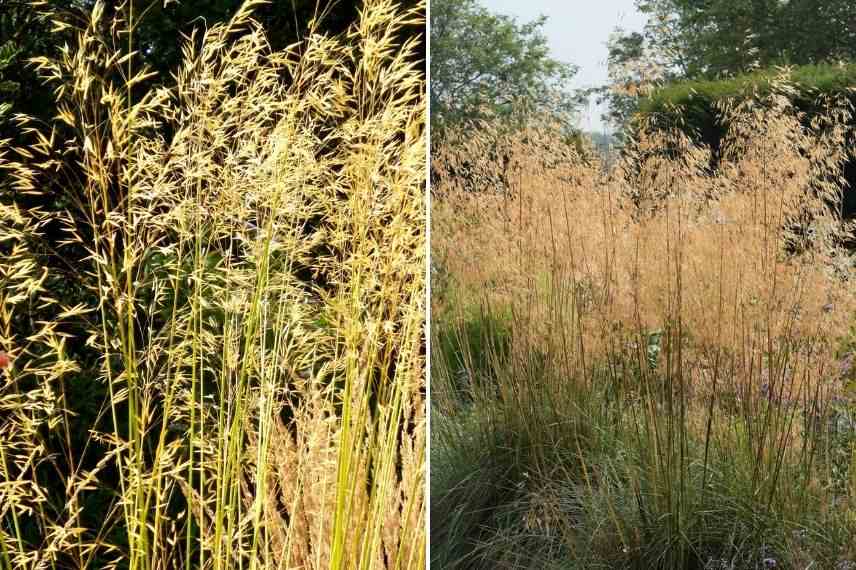
The Stipa gigantea, stunning in full sun
It complements a checkerboard of lavenders Lavandula angustifolia ‘Munstead’. This true lavender forms a regular, dense, and aromatic ball. In summer, it is covered with spikes of very bright blue-violet flowers, emerging from a persistent ash-green foliage. This small fragrant lavender is distinguished by its growth that does not become bare in the centre. The Melinis nerviglumis or Melinis rhynchelytrum is a small frost-sensitive perennial grass of sub-Saharan origin. This plant features a small, well-dense tuft of bluish-green foliage resembling a blue fescue. Its late flowering, in shades from dark pink to rosy white, is a delight.
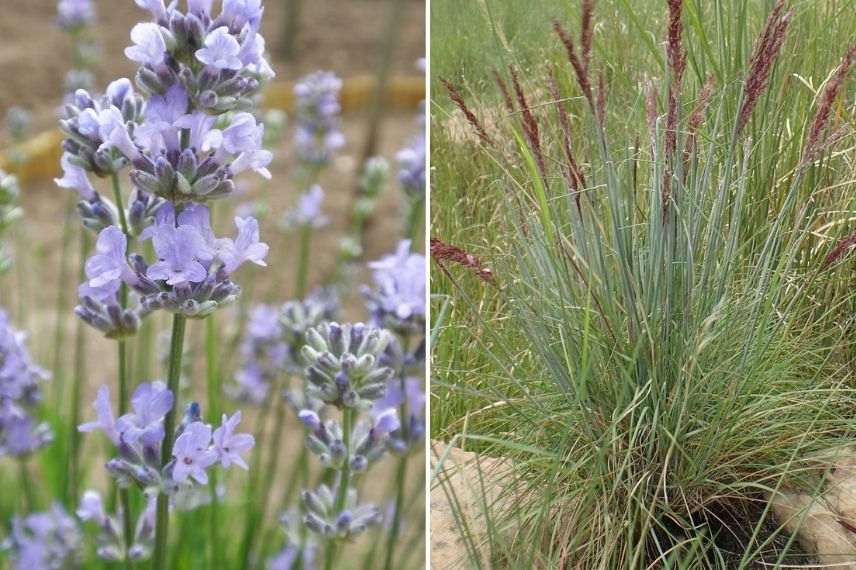
The bluish leaves of the Melinis perfectly match the soft flowering of this lavender
Discover other Ornamental grasses
View all →Available in 0 sizes
Available in 1 sizes
Available in 0 sizes
Available in 0 sizes
Available in 1 sizes
Available in 0 sizes
Available in 1 sizes
Available in 1 sizes
Available in 1 sizes
Available in 2 sizes
Lyme grass - Leymus arenarius
Leymus arenarius is a low-growing grass. With great longevity, it is attractive due to its silver-blue linear foliage covered in bloom which adds decorative interest to the plant. The broad evergreen leaves measure 8 to 15 cm wide and 60 cm long. They are flat and curled at the tip. Known as lyme grass or Sand Elymus, this Leymus flowers from June to September. It produces compact spikes, similar to wheat, measuring 15 to 30 cm long. These spikes are upright on stiff, robust stems. They are silver-blue and turn straw-coloured at the end of summer. The stump of this grass is vigorous and running, which can make it invasive. It is an ideal perennial for coastal areas.
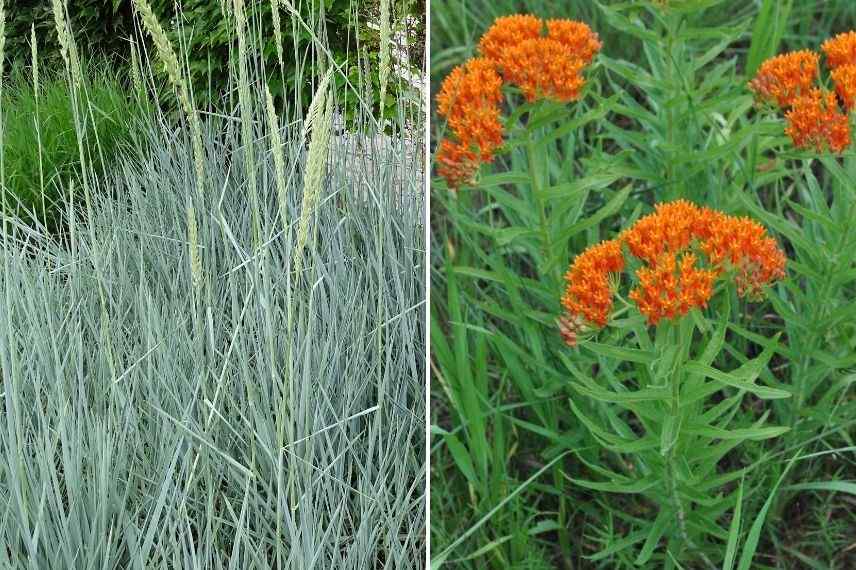 The vibrant flowering of the asclepias awakens the softness of the grasses
The vibrant flowering of the asclepias awakens the softness of the grasses
Asclepias tuberosa is a hardy tuberous perennial that pairs well with our grass due to its exotic appearance and ease of cultivation. Its vermilion-orange star-shaped flowers arranged in umbels appear from the beginning of summer. Its large bluish-green elliptical leaves are evergreen, but may disappear in harsh winters.
Read also
Pruning grassesBlue grama - Bouteloua gracilis
Bouteloua gracilis is a lovely perennial grass forming dense tufts of fine, very stiff and upright foliage, a slightly bluish green that takes on a purplish hue in autumn and then turns bronze in winter. The flower panicles consist of pink-silver to purplish spikelets, grouped in small combs, curiously arranged horizontally. This ornamental grass thrives in very dry, even poor and sandy soils, in full sun. In heavy soil, it does not live long, so it is best to plant it in a rockery or on a well-exposed sloping bank.
Erysimum linifolium ‘Variegatum’, also known as Wallflower or Velvet Flower, is a perennial that is not commonly found in our gardens. Its spring flowering, violet in colour, is accompanied by decorative foliage variegated with cream white. It is ideal for rockeries and sunny spaces. From May to July, violet flowers will appear in spikes. Classified as a decorative plant from spring to autumn, it has a medium hardiness (-7°C).
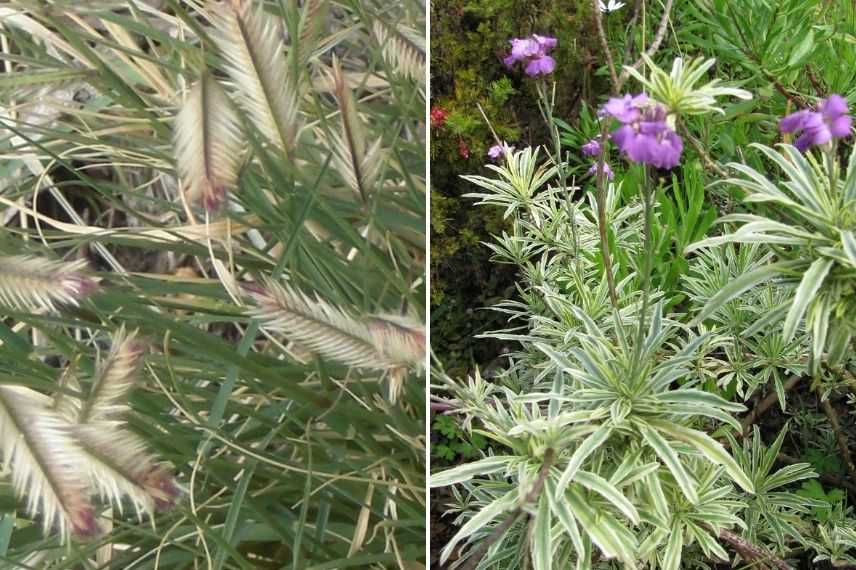
The extraordinary graphic nature of the inflorescences of Bouteloua gracilis deserves to be placed at the edge of a path or border
Mulhenbergia capillaris
Muhlenbergia capillaris thrives in full sun in well-drained, even dry and stony soil. It is sensitive to excess moisture. This grass serves as an architectural plant with an impressive height of 50 cm and up to one metre when in bloom. It is a decorative plant with very subtle colours in a range of pastel tones. Its dark blue-green foliage is streaked with grey. It highlights the pale pink of its spike flowers that are perched along endless stems for many months.
Helictotrichon sempervirens ‘Pendula’ is the ideal grass for gravel gardens, rockeries, or well-exposed slopes, as it does not particularly like wet regions and soils. The Phormium tenax ‘Dark Delight’ is a plant of great ornamental value, designed for large beds or rockeries in mild climates. It adds a very exotic charm to the garden. It enhances the large grasses.
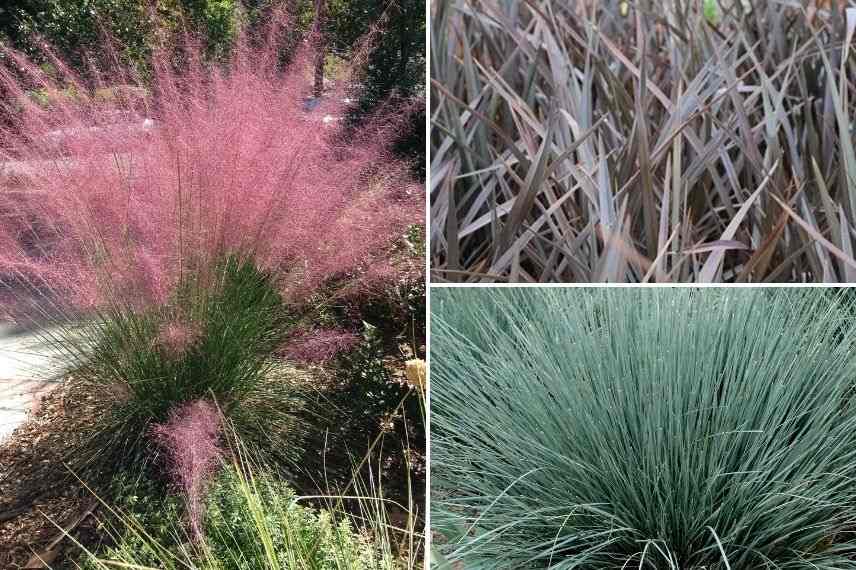
Full sun is an asset for the design of Muhlenbergia paired with purple Phormium and blue Helictotrichon
Blue fescue - Festuca glauca
Festuca glauca, or blue fescue is an ornamental grass for dry soil, highly valued for its evergreen grey-blue foliage. Compact, graphic, and colourful, it forms lovely decorative blue clumps topped with gracefully trailing silver spikelets. This perennial grass is easy to grow.
Stachys byzantina or Lamb’s ear is a perennial for well-drained soil, but preferably soft and deep. The foliage covered in very soft woolly bristles rises to 20-25 cm in height. The drier the soil, the lighter the foliage will appear, almost white. The flowering from June to August produces very cottony flower spikes. Their square stem, 40 cm tall, bears small opposite leaves that become shorter towards the top. At their tip, a spike 10 to 22 cm long develops, composed of numerous tiny flowers grouped in cut flower arrangements. Their pinkish-purple hue is enveloped in an abundance of almost white wool.
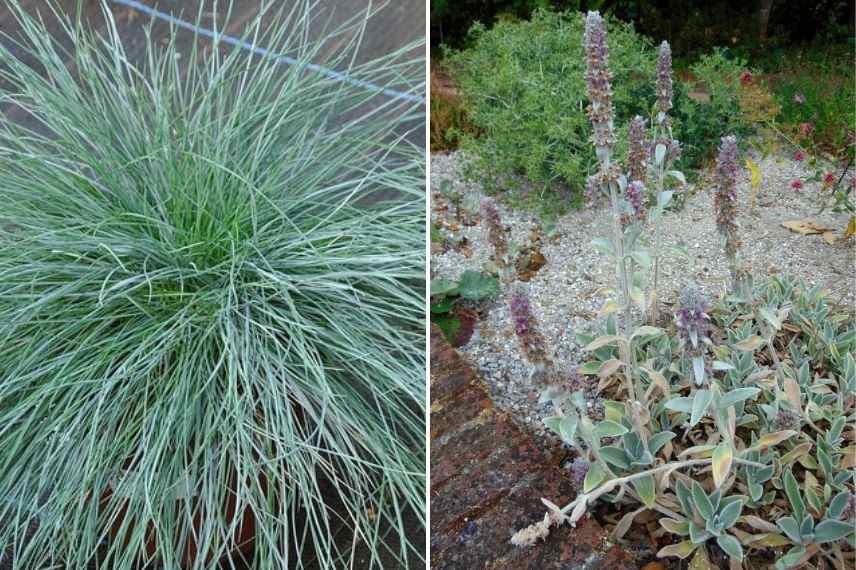
The evergreen blue foliage of the Festuca glauca serves as a backdrop for the Lamb’s Ears and their purple flowering in summer
Schizachyrium scoparium 'Prairie Blues'
The Schizachyrium scoparium ‘Prairie Blues’ is a lesser-known and underused perennial grass in our gardens. Its foliage transitions from a striking silver-blue in summer to a pink-orange hue in autumn, before turning purple in winter. This beautiful hardy variety thrives in well-drained, even poor soils, and in full sun. ‘Prairie Blues’ is a selection with a remarkable silver-blue colour. The plant forms a clump 80 cm to 1 m tall in flower, with a width of 50 cm, slowly spreading to create a bush with upright stems. Its inflorescences are narrow clusters bearing elongated spikelets, white in colour, maturing to an ash-grey to silver hue. By mid-September, the entire plant takes on orange tones with pink and purple reflections, becoming increasingly intense until November, before turning copper-purple.
The Chrysanthemum indicum ‘Orchid Helen’ or garden chrysanthemum is a true ode to autumn alongside the purple foliage of the Schizachyrium. This variety produces stunning double daisies, very dense, in a candy-pink colour with a dark pink centre. It only fears heavy, waterlogged soils in winter, requiring normal, well-drained, cool soil, especially in summer, and a bright location.
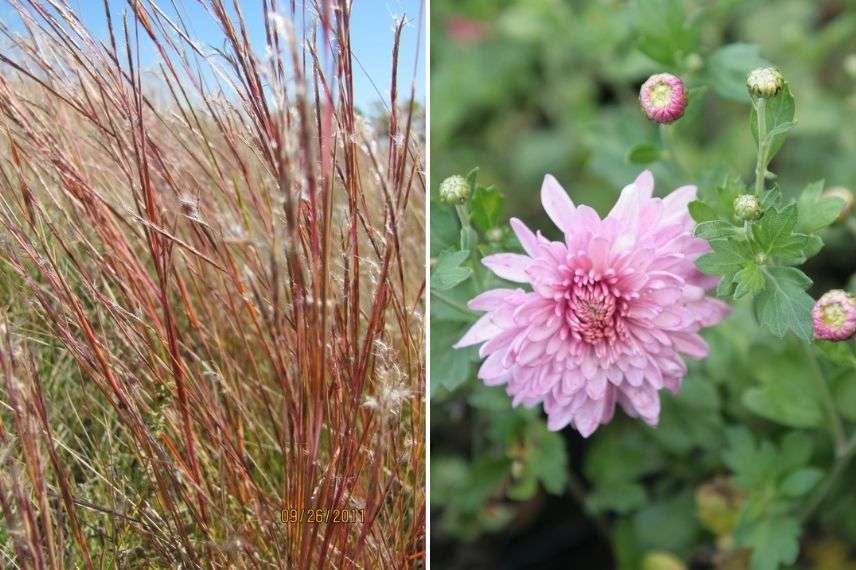
The end of summer will be adorned with the pink flowering of the garden chrysanthemum
- Subscribe!
- Contents

































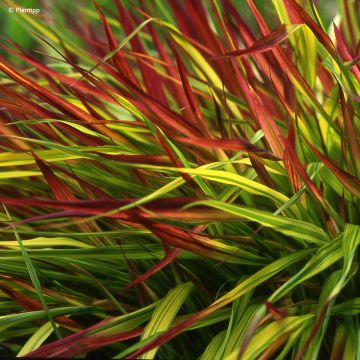
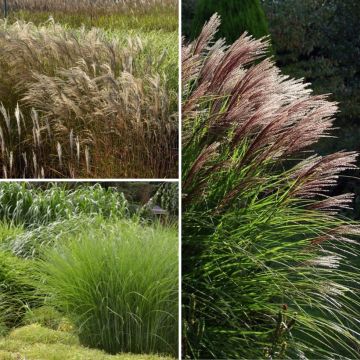
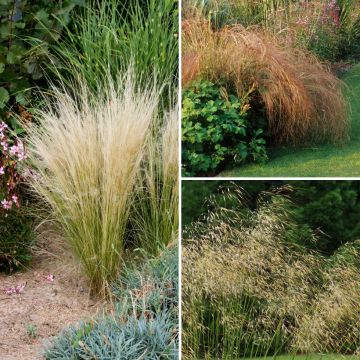
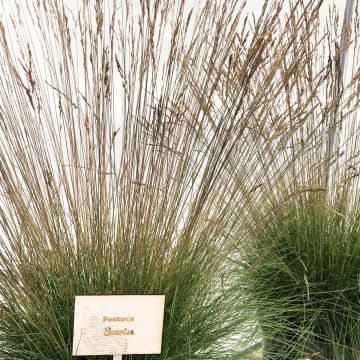
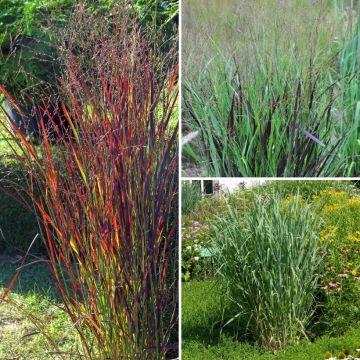
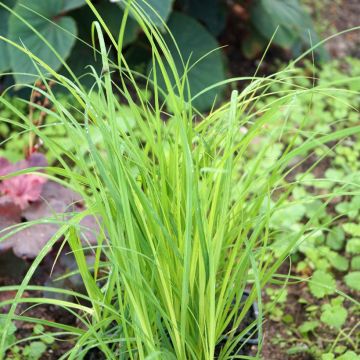

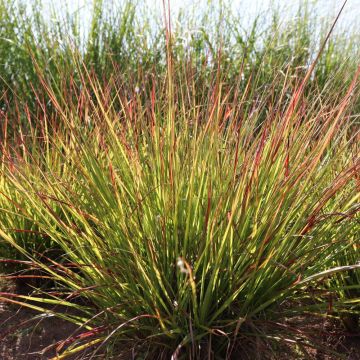
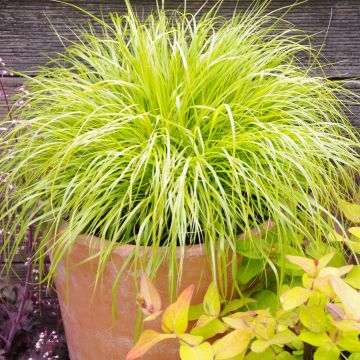
Comments